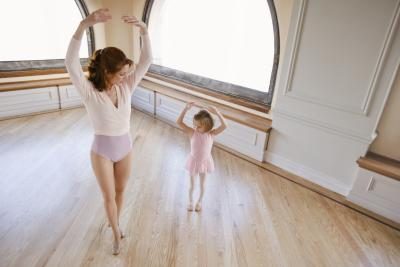Causes of Knee Pain While Dancing

Overview
The knee is a hinge joint, bearing most of the stress during dancing, walking and running. It's the largest joint in the body that can sometimes stand up to four times the weight of an individual, depending upon the motion performed. The knee straightens and bends but also has some degree of limited rotation and sliding. There's a complex structure of ligaments, tendons, cartilage, meniscus and bursae that make up the knee and allow motions such as walking, dancing, running, jumping and squatting.
Patellofemoral Syndrome

Patellofemoral syndrome is a condition of the knee that results in a discomfort around the kneecap due to mechanical issues. According to Ortho Associates physician Dr. William Heinz, this can be due to chondromalacia, a roughening of the undersurface of the knee cap, muscle imbalance or structural abnormalities. When dancers use poor technique, they can increase the potential of suffering from this condition. When there is poor turnout technique, muscle imbalances, hard floors, over-pronation, decreased hip external rotation or tight muscle groups--such as hip flexors and hamstring muscles--it places the dancer at increased risk of developing patellofemoral syndrome.
Tendinitis
According to Dr. Heinz from Ortho Associates, some of the same external and internal forces that predispose a dancer to Patellofemoral syndrome also increase the likelihood that he'll suffer pain from tendinitis. The tendinitis that a dancer suffers most often results in pain just below the kneecap or at the lower inside portion of the knee.
Plica Syndrome
This is a condition that's the result of a structural abnormality. In some instances, all fetal tissue is not absorbed or matures. As a result, there can be remnants of tissue in the knee joint that don't belong. The synovial plica are membranes within the knee that separate it into compartments during development. In most people, they continue to exist as sleeves of tissue. In some, they're more prominent and are then prone to irritation. Physicians often recommend rest, ice and anti-inflammatory medication to decrease the swelling and pain. If additional rehabilitation doesn't stop the injury from recurring, surgical removal of the plica may be considered.
Iliotibial Band Friction Syndrome
This is the leading cause of lateral knee pain in dancers, according to Dr. Rick Allen from Cascade Wellness Clinic. The band of tissue that runs from the hip to the knee is partially responsible for stabilizing the knee. Running, bicycling and dancing can cause sufficient friction over the lateral aspect of the thigh bone to cause inflammation. This inflammation causes pain over the knee with motion.
Note – This information has been taken from different internet sources.
- Choosing a selection results in a full page refresh.
